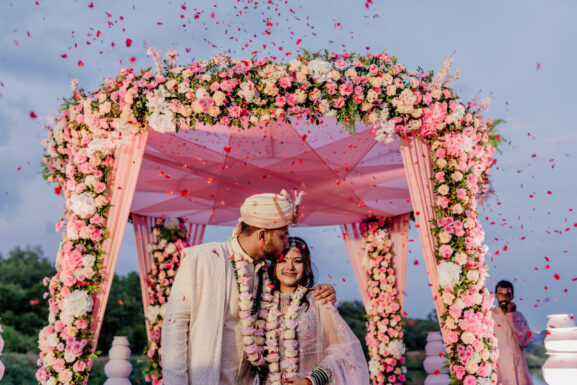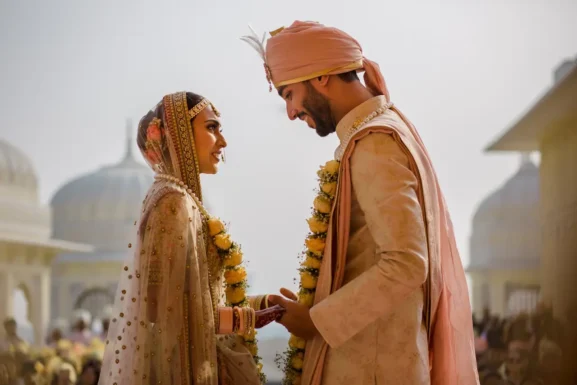South Indian Wedding Rituals Step by Step [Traditions of Grace and Spirituality]
South Indian weddings are a symphony of sacred Vedic chants, vibrant colors, divine blessings, and deep family traditions.
Rooted in ancient scriptures and celebrated with great spiritual rigor, they go beyond just the union of two individuals – they signify a cosmic and familial bond blessed by the gods and ancestors.
Each ritual, from the simplest prayer to the grandest feast, carries profound symbolism, aligning human life with dharma (duty), karma (action), and moksha (liberation).
In this guide, Plannersy walks you through South Indian wedding rituals step by step, celebrating traditions across Tamil, Telugu, Kannada, and Malayali cultures – with a special focus on South Indian Brahmin Wedding Rituals.
South Indian Wedding Rituals Step by Step
1. Pre-Wedding Rituals
a. Nischayathartham (Engagement)
- Step: Formal announcement of marriage between the two families. Exchange of rings, gifts, and sweets.
- Symbolism: It marks consent and blessing of elders, solidifying the union as per dharma.
b. Panda Kaal Muhurtham
- Step: Both families pray to their chosen deities for a smooth, obstacle-free wedding.
- Symbolism: Seeks divine grace before beginning the wedding festivities.
c. Sumangali Prarthanai (Especially in Brahmin Weddings)
- Step: Married women (Sumangalis) are honored and served special meals.
- Symbolism: Invokes blessings of prosperity, marital bliss, and longevity for the bride.
d. Kashi Yatra (Primarily Tamil Brahmin Ritual)
- Step: The groom playfully declares he is renouncing worldly life for spiritual pursuits.
- Symbolism: Represents the groom’s readiness to balance spiritual life and worldly responsibilities through marriage.
e. Pallikai Thellichal
- Step: Sprouting of nine kinds of grains in earthen pots.
- Symbolism: Signifies fertility, prosperity, and new beginnings.
2. Wedding Day Rituals
a. Mangala Snanam (Sacred Bath)
- Step: Early morning holy bath for purification. Turmeric, kumkum, and sandalwood are applied.
- Symbolism: Purifies the body and soul before entering sacred rites.
b. Ganesha and Lakshmi Puja
- Step: Prayers to Lord Ganesha and Goddess Lakshmi to remove obstacles and bless the union.
- Symbolism: Seeks an auspicious start and prosperity.
c. Vara Puja / Groom Welcome
- Step: Groom is welcomed by the bride’s family, and his feet are washed as a mark of respect.
- Symbolism: Acknowledging the groom as Lord Vishnu arriving to marry Goddess Lakshmi (the bride).
d. Muhurtham Ceremonies (The Sacred Wedding Hour)
Antarpat (Separation Cloth)
- Step: A curtain (antarpat) separates the couple at the mandap, removed at the precise muhurtam (auspicious moment).
- Symbolism: Symbolizes the transition from two individuals to a unified soul.
Kanyadaanam
- Step: The bride’s father offers her hand to the groom.
- Symbolism: Considered the highest form of charity — giving away one’s daughter.
Mangalya Dharanam (Thaali Tying Ceremony)
- Step: Groom ties the thaali (sacred gold necklace) around the bride’s neck amidst auspicious chants and drumbeats.
- Symbolism: Represents the divine bond of marriage, protection, and love.
Saptapadi (Seven Sacred Steps)
- Step: The couple takes seven steps together around the sacred fire.
- Each Step Vow: Nourishment, strength, prosperity, happiness, progeny, health, and lifelong companionship.
Pradhana Homam (Sacred Fire Offerings)
- Step: The couple offers prayers into the holy fire together.
- Symbolism: Strengthens the bond before Agni (the sacred witness).
Ammi Midithal (Grinding Stone Ritual)
- Step: Bride places her foot on a stone; the groom holds her toe while reciting mantras.
- Symbolism: Represents strength, stability, and steadfastness in facing life’s challenges.
3. Post-Wedding Rituals
a. Talambralu (In Telugu Weddings)
- Step: Couple showers each other with a mixture of rice, turmeric, and flowers.
- Symbolism: Symbolizes abundance, prosperity, and playful love.
b. Griha Pravesham
- Step: The bride enters the groom’s home with a pot of rice, gently kicking it.
- Symbolism: Welcoming prosperity, abundance, and the goddess of wealth into the new home.
c. Satyanarayana Puja
- Step: Conducted at the groom’s home to seek Lord Vishnu’s blessings for a happy married life.
- Symbolism: Marks spiritual harmony and gratitude.
d. Reception (Sadhya / Virundhu)
- Step: A grand celebratory feast is hosted by the groom’s family.
- Symbolism: Publicly introducing the bride and celebrating with the extended community.
Key South Indian Brahmin Wedding Rituals (Tamil, Telugu, Kannada, and Malayalam)
| Ritual | Description | Symbolism |
|---|---|---|
| Vedic Chanting | Throughout the wedding, priests chant Rigvedic or Yajurvedic mantras. | Invokes cosmic energies for blessings. |
| Kankanam Tying | Sacred thread tied to the wrists of bride and groom. | Protection from evil spirits and purification. |
| Kasi Yatra | Groom symbolically renounces worldly life before marriage. | Acceptance of householder life as a sacred duty. |
| Oonjal Ceremony | Swing ritual before the mandap ceremony. | Symbolizes life’s ups and downs — to be balanced together. |
| Laja Homam | Offering puffed rice into the fire. | Prayers for prosperity and family well-being. |
| Sapta Padi | Seven steps together. | Eternal bond witnessed by fire and gods. |
| Ammi Midithal | Bride stepping on the stone. | Strength and courage in married life. |
Regional Flavors in South Indian Weddings
- Tamil Weddings: Strong Brahmin traditions, Kasi Yatra, Ammi Midithal, Oonjal swing ritual.
- Telugu Weddings: Talambralu (rice showering), tying of three knots, Jeelakarra Bellam (paste of cumin and jaggery placed on heads).
- Kannada Weddings: Kashi Yatre, Mandap Puja, Dhare Herdu (water pouring ritual during Kanyadaan).
- Malayali Nair Weddings: Simpler ceremonies focused around brief yet meaningful rituals like tying the Minnu (cross-shaped thaali).
Why South Indian Weddings Are Treasured Worldwide
South Indian weddings are a perfect balance of solemn spirituality, colorful vibrancy, and emotional storytelling.
Each ritual, from chanting mantras to playful rice showers, is a beautiful dialogue between the divine and the human.
Modern couples lovingly honor these traditions while adding personal touches – eco-friendly weddings, fusion Thaali designs, personalized Vedic chants – making the celebration even more meaningful.
Plannersy Pro Tip:
When planning a South Indian wedding, respect the core traditions but personalize wherever your heart calls!
Choose experienced priests, involve elders early, and embrace the rich symbolism – because every chant, every step, every smile is a blessing echoing through generations.
Final Note:
Loved this deep dive into South Indian wedding rituals?
Share it with brides, grooms, wedding planners, and culture enthusiasts!
For more step-by-step guides on Indian wedding traditions, keep following Blog Plannersy.
Related Reads:

![South Indian Wedding Rituals Step by Step [Traditions of Grace and Spirituality]](https://plannersy.com/wp-content/uploads/2025/04/South-Indian-Wedding-Rituals-India-Step-by-Step-Plannersy-min-900x500.webp)


Pingback: Hindu Wedding Rituals Step by Step [A Journey of Sacred Union]
Pingback: The Iyer Wedding Rituals, Step by Step [A Sacred Symphony]
Pingback: Indian Wedding Sweets Menu for Every Celebration - Plannersy
Pingback: Scenic Pre-Wedding Photoshoot Locations in Bangalore
Pingback: Mahabalipuram Shore Temple Wedding Cost: Complete Guide